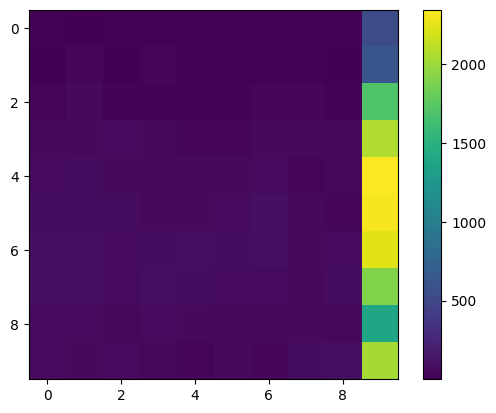Last Number Revisited with a Hidden Layer#
Let’s redo our last number example, now with a hidden layer.
import numpy as np
import random
We’ll use the categorical data class from before
class ModelDataCategorical:
"""this is the model data for our "last number" training set. We
produce input of length N, consisting of numbers 0-9 and store
the result in a 10-element array as categorical data.
"""
def __init__(self, N=10):
self.N = N
# our model input data
self.x = np.random.randint(0, high=10, size=N)
self.x_scaled = self.x / 10 + 0.05
# our scaled model output data
self.y = np.array([self.x[-1]])
self.y_scaled = np.zeros(10) + 0.01
self.y_scaled[self.x[-1]] = 0.99
def interpret_result(self, out):
"""take the network output and return the number we predict"""
return np.argmax(out)
Now our network will store an additional array, \({\bf B}\), and take the size of the hidden layer as an input.
class NeuralNetwork:
"""A neural network class with a single hidden layer."""
def __init__(self, num_training_unique=100,
data_class=None, hidden_layer_size=20):
self.num_training_unique = num_training_unique
self.data_class = data_class
self.train_set = []
for _ in range(self.num_training_unique):
self.train_set.append(data_class())
# initialize our matrix with Gaussian normal random numbers
# we get the size from the length of the input and output
model = self.train_set[0]
self.N_out = len(model.y_scaled)
self.N_in = len(model.x_scaled)
self.N_hidden = hidden_layer_size
# we will initialize the weights with Gaussian normal random
# numbers centered on 0 with a width of 1/sqrt(n), where n is
# the length of the input state
rng = np.random.default_rng()
# A is the set of weights between the hidden layer and output layer
self.A = rng.normal(0.0, 1.0/np.sqrt(self.N_hidden),
(self.N_out, self.N_hidden))
# B is the set of weights between the input layer and hidden layer
self.B = rng.normal(0.0, 1.0/np.sqrt(self.N_in),
(self.N_hidden, self.N_in))
def g(self, xi):
"""our sigmoid function that operates on the layers"""
return 1.0/(1.0 + np.exp(-xi))
def train(self, n_epochs=10, eta=0.2):
"""Train the neural network by doing gradient descent with back
propagation to set the matrix elements in B (the weights
between the input and hidden layer) and A (the weights between
the hidden layer and output layer)
"""
for _ in range(n_epochs):
random.shuffle(self.train_set)
for model in self.train_set:
# make the input and output data column vectors
x = model.x_scaled.reshape(self.N_in, 1)
y = model.y_scaled.reshape(self.N_out, 1)
# propagate the input through the network
z_tilde = self.g(self.B @ x)
z = self.g(self.A @ z_tilde)
# compute the errors (backpropagate to the hidden layer)
e = z - y
e_tilde = self.A.T @ (e * z * (1 - z))
# corrections
dA = -2 * eta * e * z * (1 - z) @ z_tilde.T
dB = -2 * eta * e_tilde * z_tilde * (1 - z_tilde) @ x.T
self.A[:, :] += dA
self.B[:, :] += dB
def predict(self, model):
""" predict the outcome using our trained matrix A """
z = self.g(self.A @ (self.g(self.B @ model.x_scaled)))
return model.interpret_result(z)
def check_accuracy(self):
"""use the trained network on the training data and return
the fraction we get correct"""
n_right = 0
for model in self.train_set:
y_nn = self.predict(model)
if y_nn == model.y:
n_right += 1
return n_right / len(self.train_set)
def test_unseen(self, num=1000):
"""use the trained network on data it hasn't seen and
return the fraction we get correct"""
n_right = 0
for _ in range(num):
model = self.data_class()
y_nn = self.predict(model)
if y_nn == model.y:
n_right += 1
return n_right / num
Let’s see the accuracy with a hidden layer added
nn = NeuralNetwork(num_training_unique=1000,
hidden_layer_size=50, data_class=ModelDataCategorical)
nn.train(n_epochs=100)
first on the data we trained on
frac = nn.check_accuracy()
print(f"fraction correct: {frac}")
fraction correct: 0.729
now on data we haven’t seen
frac = nn.test_unseen()
print(f"fraction correct: {frac}")
fraction correct: 0.643
Effect of the number of epochs#
Let’s see what effect the number of epochs has.
n_epochs = [1, 2, 4, 8, 16, 32, 64, 128]
accuracy_trained = []
accuracy_unseen = []
for nep in n_epochs:
nn = NeuralNetwork(num_training_unique=1000,
hidden_layer_size=50, data_class=ModelDataCategorical)
nn.train(n_epochs=nep)
accuracy_trained.append(nn.check_accuracy())
accuracy_unseen.append(nn.test_unseen())
import matplotlib.pyplot as plt
fig, ax = plt.subplots()
ax.plot(n_epochs, accuracy_trained, label="training data")
ax.plot(n_epochs, accuracy_unseen, label="unseen data")
ax.set_xscale("log")
ax.set_xlabel("# of epochs")
ax.set_ylabel("accuracy")
ax.legend()
<matplotlib.legend.Legend at 0x7f05b04fc6e0>

Increasing the number of epochs seems to help with both the training and unseen data.
Effect of the training sample size#
Now let’s vary the size of the training sample
ntrain = [10, 30, 100, 300, 1000, 3000, 10000]
accuracy_trained = []
accuracy_unseen = []
for nt in ntrain:
nn = NeuralNetwork(num_training_unique=nt,
hidden_layer_size=50, data_class=ModelDataCategorical)
nn.train(n_epochs=100)
accuracy_trained.append(nn.check_accuracy())
accuracy_unseen.append(nn.test_unseen())
fig, ax = plt.subplots()
ax.plot(ntrain, accuracy_trained, label="training data")
ax.plot(ntrain, accuracy_unseen, label="unseed data")
ax.set_xscale("log")
ax.set_xlabel("# of training pairs")
ax.set_ylabel("accuracy")
Text(0, 0.5, 'accuracy')

Here the number of training pairs helps most with the unseen data. This makes sense, because we have less of a chance of “memorizing” the training data if there is a lot of it.
Effect of hidden layer size#
nhidden = [5, 10, 20, 50, 100, 200]
accuracy_trained = []
accuracy_unseen = []
for nh in nhidden:
nn = NeuralNetwork(num_training_unique=1000,
hidden_layer_size=nh, data_class=ModelDataCategorical)
nn.train(n_epochs=100)
accuracy_trained.append(nn.check_accuracy())
accuracy_unseen.append(nn.test_unseen())
fig, ax = plt.subplots()
ax.plot(nhidden, accuracy_trained, label="training data")
ax.plot(nhidden, accuracy_unseen, label="unseen data")
ax.set_xscale("log")
ax.set_xlabel("hidden layer size")
ax.set_ylabel("accuracy")
ax.legend()
<matplotlib.legend.Legend at 0x7f05a1818ad0>

The size of the hidden layer helps a bit, but it seems to saturate after a while.
Tip
By far the best improvement we can get for unseen data is to train it on a larger number of training data pairs. If we show it more variety, then it is not overconstraining to just the data that it has seen.
A final look#
Let’s run the network one last time, with a large number of training pairs and a large hidden layer and try to understand what the trained matrices look like.
nn = NeuralNetwork(num_training_unique=5000,
hidden_layer_size=100, data_class=ModelDataCategorical)
nn.train(n_epochs=100)
nn.check_accuracy()
0.8832
nn.test_unseen()
0.848
Excluding the activation function, the action of the network is to do \({\bf A B x}\), so lets look at the matrix \({\bf A B}\)
fig, ax = plt.subplots()
im = ax.imshow(np.abs(nn.A @ nn.B))
fig.colorbar(im, ax=ax)
<matplotlib.colorbar.Colorbar at 0x7f05a1c77620>

Notice that all of the large elements are in the last column—that is what “sees” the last element in the input vector \({\bf x}\).


